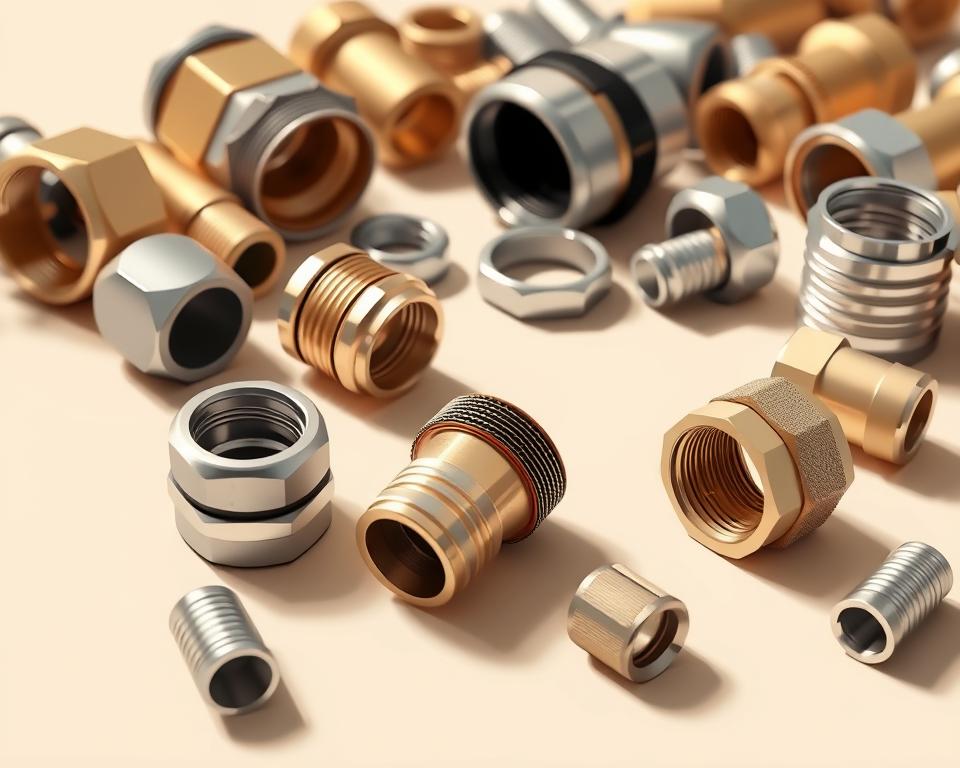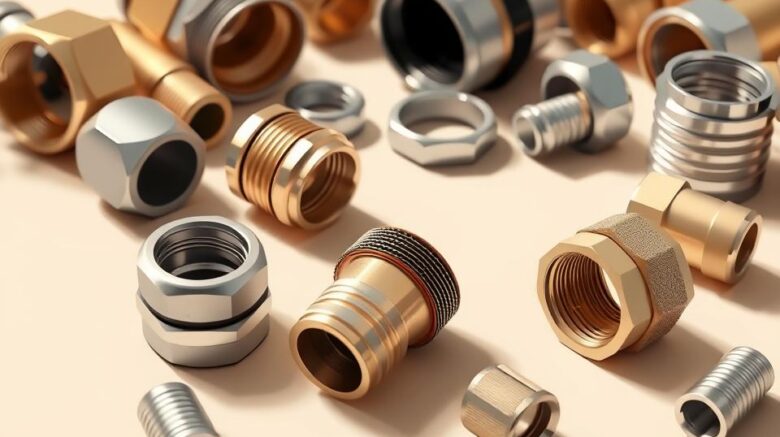Essential Yard Accessories: Standard Garden Hose Fittings
Puzzled by leaks and weak flow in your garden hose setup? The answer often lies in the small but mighty garden hose connection size parts connecting everything—standard garden hose fittings. They preserve flow, guard against leaks, and support a healthy yard.
Installation Parts Supply, a trusted provider of plumbing solutions, highlights that 67% of hose failures stem from poor-quality or mismatched connectors. The right fittings make all the difference, whether you’re setting up a simple sprinkler or a complex irrigation system.
Most connectors follow the ANSI ¾”-11.5 NH thread size, ensuring broad compatibility. This overview shows you how to select tough components, confirm pressure specs, and dodge pitfalls. Upgrade your setup with confidence!
Important Notes
- Good connectors halt leaks and save water.
- ANSI ¾”-11.5 NH (3/4″) is the universal thread size.
- Trust Installation Parts Supply for quality connectors.
- Durability hinges on chosen materials and pressure ratings.
- 67% of hose breakdowns begin at bad fittings.

The Importance of Picking Proper Garden Hose Fittings
Did you know leaky connections waste more water than you think? Poor-quality parts account for 40% of water loss in irrigation systems. That’s water flowing away as if you’d left a faucet wide open!
Incompatible components also slash water pressure by 15–20%. Your spray may fall short of the grass. Pro tip: Keep pressure-washer hoses under 50 feet for best flow.
Don’t overlook safety issues. Burst connections at high PSI can injure users or damage equipment. Their reinforced, pressure-rated fittings stop dangerous ruptures.
Longevity is crucial. Corrosion-resistant materials last years longer, especially in salty or humid climates. Quick-connect fittings often crack in frost—check them each season.
Installing quality connectors delivered a 35% gain in sprinkler performance. The right parts save water, time, and money—no guesswork needed.
What Makes a Garden Hose Fitting
What makes some hose connections last for years while others fail in months? It comes down to parts like ferrules, seals, and threads. Each element works to seal and sustain pressure.
Grooved ferrules clamp the hose and prevent pull-offs. Smooth ferrules excel under pressure. Barbed ferrules secure hoses but risk flow restriction if crooked.
Washers do the heavy lifting in leak prevention. Loose or old washers lead to leaks. Press it firmly into the groove before tightening—this simple step saves water and frustration.
Thread engagement depth matters too. Fully engage the threads to avoid leaks. Even slight gaps let water escape. One-piece connectors offer greater durability than separable designs.
Their anti-kink feature guards against kinks and wear. It stops kinks that strain fittings. Rotate O-ring inspections every three months to preserve sealing.
A quality fitting outperforms and outlasts. Choose the right size and style to sidestep problems.
Types of Garden Hose Fittings: Which One Do You Need?
Overwhelmed by all the fitting types? Let’s clarify the choices. Every fitting style—quick-connect, swivel, regulator—has its role.
Quick-disconnects save time when switching tools. Plastic for easy tasks; brass for tougher, higher-PSI work. Installation Parts Supply’s frost-proof valves add winter durability—no more cracked parts after freezing temps.
Swivel fittings offer *270° rotation*, preventing kinks when moving sprinklers. Y fittings split flow for dual-hose operation. Commonly used for simultaneous patio washing and plant watering.
Pressure-regulating adapters protect sprinklers from surges. They stabilize flow when upstream PSI jumps. Check the table below to compare costs and performance:
| Type | Material | Cost | Flow Rate (GPM) |
|---|---|---|---|
| Quick-Connect | Plastic | $1.50 | 4.2 |
| Quick-Connect | Brass | $8.00 | 5.1 |
| Y-Splitter | Aluminum | $6.50 | 3.8 (per outlet) |
Camlock fittings offer secure, leak-free connections for rugged use. Stainless builds stand up to harsh chemicals and fertilizers. Most home systems call for ¾” ANSI threads.
Pro tip: Keep spare washers for each fitting type. Worn seals can sap pressure by 20% before visible drips appear.
Fitting Materials Compared
Connector materials determine strength and longevity. Brass leads with a 500 PSI rating, while plastic caps at 150 PSI. Prop 65–compliant lead-free brass safeguards drinking water.
Aluminum resists corrosion better than plastic, which degrades under UV rays. Metal fittings survive heat and cold; plastic can shatter in frost. Installation Parts Supply’s brass-aluminum hybrids offer the best of both worlds.
Plastic’s place in your system Light-duty drip and short-run applications. Compare plastic, brass, and hybrid in the chart:
| Type | Material | Cost | Max PSI |
|---|---|---|---|
| Coupler | Plastic | $4 | 150 |
| Coupler | Brass | $12 | 500 |
| Hybrid | Brass-Aluminum | $9 | 400 |
Choose fittings by climate and PSI for lasting use. A single brass coupling beats plastic versions threefold in lifespan.
Choosing Hose Size
Your hose size determines GPM and spray distance. 3/4″ hoses flow about 5 GPM, ideal for sprinklers. 5/8″ hoses cap out at 3 GPM for soft watering.
Pressure drops down a long hose. Count on roughly 1 PSI per foot lost. Pressure washers need 50-foot maximums to maintain strong flow. Use their adapters to join different diameters leak-free.
Length vs. coverage:
- Covers small spaces well.
- 50 ft: Covers medium lawns (up to 1,500 sq ft).
- 100 ft: Requires higher pressure to reach edges evenly.
Commercial setups often use 1-inch fittings for heavy flow. They supply greater flow for large areas. Check this comparison for quick decisions:
| Diameter | Flow Rate (GPM) | Best For |
|---|---|---|
| ⅝ inch | 3 | Drip irrigation, small gardens |
| ¾ inch | 5 | Sprinklers, car washing |
| 1 inch | 7+ | Agriculture, large properties |
Plan your watering specs before you buy. 3/4″ works for most yards, but hose length is equally important. Use adapters to adapt hoses and tools without leaks.
Fitting Compatibility & PSI Ratings
Why do fittings give way when PSI jumps? Check the PSI ratings. A 150 PSI fitting works under steady flow but may fail at 300+ PSI surges.
Working PSI is different from burst PSI. A 300 PSI rating means the part withstands surges, not constant flow. Their industrial fittings endure surges—perfect for pressure washers and farms.
Thermal buildup can cause pressure spikes. Water heating in sun-exposed lines increases pressure by 5–10 PSI per 10°F. Add loops to let hoses expand safely.
Pressure Ratings at a Glance
| Rating | Best For | Burst Strength |
|---|---|---|
| 150 PSI | Residential sprinklers | 450 PSI |
| 300 PSI | Irrigation systems | 900 PSI |
| 600 PSI | Industrial use | 1,800 PSI |
Thread mismatches cause 30% of leaks. Match adapter PSI to your setup to avoid leaks. One farm’s switch to 300 PSI brass fittings reduced leaks by 40%.
Mixing Old and New? Follow This Checklist
- Match thread types (e.g., ANSI ¾”-11.5 NH).
- Check O-rings for damage before reuse.
- Test pressure tolerance of older parts.
- Replace corroded or dented connectors.
Your *type hose* and tools dictate *water pressure* needs. Smart prep saves you from failures.
Installation and Maintenance Tips
A little care goes a long way in keeping your connections leak-free. Inspect yearly for damage, corrosion, or wobble. Secure any loose components right away.
Leak detection is straightforward. Attach your setup to a *faucet*, turn on the water, and look for drips. Focus on joints first. Their gauge makes hidden leaks obvious.
For freezing climates, winterize your system. Empty hoses and stow inside. Use insulated covers on outdoor spigots. This prevents bursts that can ruin your *hose needs*.
Grab these items:
- Adjustable wrench for firm connections
- Thread seal tape to stop slow leaks
- Spare washers and a guide sheet
Swap washers biannually. Use correct-size washers—wrong ones cause 30% of leaks. Have spares on hand for quick fixes.
Store hoses coiled in shade. UV rays weaken materials over time. Use a rack or reel for neat, ready hoses.
Persistent leak? These steps:
- Brush threads clean of grit
- Lubricate O-rings with plumbers’ grease
- Replace damaged washers right away
Conclusion: Nail the Right Hose Fittings
The first step to a better watering system is choosing the right fittings. Select brass, aluminum, quick-disconnect, or swivel based on your needs.
Premium connectors deliver long-term value. Brass fittings often pay for themselves in longevity. Warrantied fittings ensure worry-free use.
Keep this guide handy:
- Check pressure ratings before buying
- Examine O-rings seasonally
- Winterize and store inside
Watch for upcoming fittings that detect drips. Meanwhile, ask the pros to get job done properly. Your garden hose rig deserves superior connectors!
